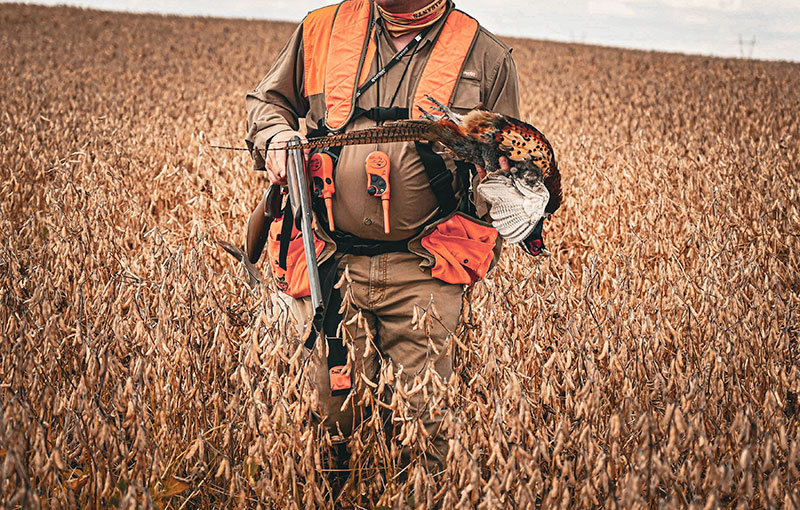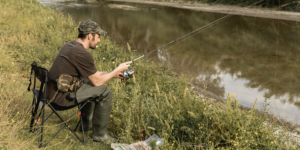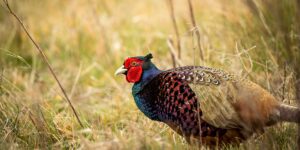Public land, private land, hunting preserves—important information on where you can hunt pheasants this fall.
Since their introduction to the United States 200 years ago, pheasants have become one of the most recognizable upland bird species and a favorite quarry to hunt by seasoned and new hunters alike.
Recognized primarily for their stunning plumage of brightly colored feathers, white ringed neck, and their long, elegant tail feathers, pheasant hunting offers hunters a unique and challenging hunt. If you’re lucky enough to connect on a fast flying rooster, you’ll be rewarded with not only a beautiful game bird in the bag, but also delicious table fare.
If you find yourself interested in becoming a pheasant hunter, read on.
Why limit yourself to public land when there are millions of acres of private land to explore.
Understanding Hunting Seasons
Upland bird hunting is managed by each state’s Division of Wildlife, which means hunting seasons for pheasant vary state to state. Pheasants are hunted both as wild birds on private and public lands, and on what are referred to as hunting preserves.
Wild pheasants are born and raised by native wild hens (females) and roosters (males). Generally, pheasant hunting seasons run from mid-October till the first of the year, depending on the state you plan on hunting. When hunting wild pheasants, only males (roosters) can be shot, and you may only take a certain number of roosters a day—generally around two to three. It’s important to check your state game laws regarding daily bag limits and seasons before you head afield to hunt pheasants.
Hunting preserves have “pen-raised” pheasants by breeding them in their facilities. On preserves, pheasant hunters are hunting private land game birds. Pheasant hunters on preserves can shoot both hens and roosters, and their daily limit of birds allowed to be shot is much higher. On some preserves, the pheasant hunter pays per bird on how many they would like the opportunity to hunt; while on other preserves, a certain number of birds are released and placed in private fields before the start of each season. Hunting preserve seasons run longer than wild pheasant hunting seasons. Pheasant hunters can typically hunt preserves seven months out of the year beginning in September and ending in late March, depending on state regulations.
How to Identify Pheasant Habitat
Understanding pheasant habitat will be key to your success this fall. Land management is vitally important for upland species such as pheasant, but what type of habitat are you looking for?
Your most important habitat foliage to look for is simple: grass. Pheasants feed in tall grasses, nest in it, and hide in it from predators year round. The grass can be thick Conservation Reserve Program (CRP) grasses, native prairie grasses, pasturelands, strips along crop edges, wildflowers, and more.
Grasses aren’t the only places pheasants will live. You can also find them in late winter in cattail marshes, ditches, shelterbelts, corn fields, dense grass along fence rows, and even in a row of cedar trees. But the most important thing to finding pheasants is to look for cover, food, and water. Where you find all three, you will find pheasants.
Pheasants do find food in the grass cover they seek, but they utilize crop fields to fill their diets. Look for corn, grain such as milo, wheat, and oat, and soybeans. Look for CRP or other grasses that are within a close proximity or adjacent to crop fields or water. Pheasants will travel between the two for feed and cover. Where you find food and cover, you will find pheasants.

Where to go Pheasant Hunting: Public vs Private Land
Once you understand the best habitat to hunt pheasant and make sure you are hunting in season, you generally have 2 choices, either hunt on public land or private land. Public land consists of particular parkland, forested areas, and fields specifically designated for hunting. Rules and regulations for public hunting vary by state, so make sure to check your state’s DNR website before going out for the hunt. Hunting private land, on the other hand, has its own set of restrictions and there are various types to consider. Below we explain the pros and cons for hunting pheasants on public land, pheasant preserves, and private land.
Public Land
Pros: Public land access for game birds is open to all hunters. This means that thousands of acres of prime habitat are free for you to hunt pheasants on and your hunting opportunities are endless. The only cost to you is gas to get you there and hunting gear. Chasing pheasants on public land is a challenge but very rewarding when you connect on a long-tailed rooster.
Hunting wild roosters is a challenge and opens opportunities for hunters to experience new states and varying terrain. Bagging a wild rooster after hunting hard over many miles is a very rewarding experience for upland bird hunters. Gun dogs also benefit from hunting wild birds. Unlike preserves where opportunities are endless, pheasants in the wild teach bird dogs valuable skills when it comes to hunting upland birds, including terrain they inhabit, how birds move through terrain, how much distance to give birds before they flush, and more.
Cons: Public land roosters act like wild animals are expected to act: wild and weary. They are always on high alert and ready to flush to the next county when they sense danger. Since public access for game birds is open to all hunters, public lands can see a lot of hunting pressure. This hunting pressure can cause birds to be skittish and flush out of shotgun range, making your chances at bagging a bird a bit lower. In other words, shot opportunities are not guaranteed and many miles can be covered over rough terrain without flushing a bird.
Pheasant Preserves
Pros: Preserves are not only good for seasoned pheasant hunters but are perfect for new hunters who are learning the ins and outs of bird hunting. Learning to walk with a shotgun through thick cover and shoot a bird on the wing can seem intimidating to new hunters. Preserves offer many opportunities for game birds and are a perfect opportunity for practice. They also offer hunters a fun day afield for those who do not live near wild pheasant populations. Additionally, preserves are ideal for exposing your gun dog to many birds. Pointing and flushing/retrieving breeds all benefit from multiple bird exposure during hunts.
Cons: Hunting bird preserves includes a hefty price tag. Hunters should be ready to shell out the Benjamins, whether that be per bird or per hunt.
Private Land
Pros: Private or leased land gives sportsmen and women opportunities at hunting pheasants that may not be as heavily pressured and educated. Private lands are only hunted through permission, and private landowners may limit how many hunters are allowed each season. This lack of pressure is ideal for upland hunters looking for more contacts on wild birds.
Cons: Accessing private hunting land is typically expensive or can take a lot of effort and headaches to build the right relationships needed to secure entry. If you’re willing to pay, you can sometimes find leases for hunting or you can join a club, or pay a guide -all of which can be prohibitively expensive.
Affordable Private Land Access
For those wanting to hunt private land to leave the crowds behind but can’t afford to lease land, also have options. Wing It offers hunters a platform to reserve access to private lands with a small activity and service fee.
Through an online platform, pheasant hunters are shown private land options in their area that offer prime pheasant hunting habitat. Property owners set fair prices for hunters to access the land for the day, or multiple days. Wing It offers free memberships where members pay more for access, or discounted access fees for Wing It members.
Through Wing It, pheasant hunters now have access to millions of acres of private hunting land for just a small usage fee.
Click on one of the map pins below to learn more about the properties.
Conclusion
Whether you decide to hunt pheasants on public or private land, or on a hunting preserve close to home, the decision is yours. Both offer opportunities for adventure for both experienced and novice pheasant hunters, and are a guarantee to hook you into the realm of pheasant hunting for years to come.
Why limit yourself to public land when there are millions of acres of private land to explore.
FAQ
How hard is pheasant hunting?
Pheasant hunting requires walking—and a lot of it. Not only that, but it requires walking through and over rough terrain such as thick grass, rolling prairies, wet sloughs, and more. Be prepared to put a lot of miles on the boots. Prep your body and legs for the season by exercising many weeks in advance of the season opener.
What is the best gauge for pheasant hunting?
The gauge you decide on for hunting pheasant is all about preference. The most popular shotgun gauge is the 12-gauge, but that doesn’t necessarily mean it is the best gauge for you. A 12-gauge shotgun is heavier than a smaller gauge such as 20- or 16-gauge, so you have to keep that in mind before heading afield. Extra weight in a shotgun can take a toll on you after a few hours of hunting, as can the extra recoil. A 12-gauge is a solid all around choice for hunting, but a 20-gauge is also an optimal choice. It’s best to hit the range long before the season starts to see what gauge and shotgun works best for you.
What is the best choke for pheasant hunting?
Pheasants are big birds and take a lot of power to bring them down, that means choosing an appropriate choke tube to do so is important. Generally, Improved Cylinder and Modified are the go-to choke choices for pheasants (and most upland birds). An improved Cylinder is best for close flushing birds that will be within 20 yards or so, while a Modified will reach out to 30 yards or more for roosters that flush a little farther out.
What is the best time to hunt pheasant?
The good thing about pheasant hunting is that they are active all day. Play the weather. Choose early mornings and evenings to beat the heat, especially if hunting with a bird dog. If the weather is cool throughout the day, plan on taking your time in the morning and hunting the afternoon and evening.
Do you need to have a dog for pheasant hunting?
No, you do not need a dog to pheasant hunt. But if you don’t have a bird dog to hunt the thick stuff, you’ll have to do it yourself. Plan on hiking where a bird dog would to flush your own birds out of thick cover. Watch carefully where your bird falls after being shot and go directly to that spot so you can retrieve the downed bird. Your nose isn’t as good as a bird dogs to find downed game in thick cover, so you’ll have to rely on your eyes only.



